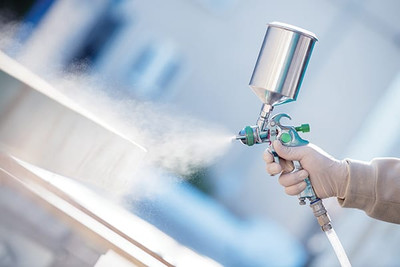28th Aug 2024
Glass bead blasting is a popular and versatile surface treatment process used across various industries. But what exactly is glass bead blasting, and why is it so widely used? In this blog, we'll dive into the details of glass bead blasting, including how it works, its benefits, and its common applications.
What is glass bead blasting?
Glass bead blasting is a type of abrasive blasting that uses fine, spherical glass beads to clean, finish, or polish surfaces. Unlike other abrasive media, such as steel shot, glass beads are non-angular and smooth, which makes them ideal for achieving a uniform finish without damaging the underlying material.
How does glass bead blasting work?
The process of glass bead blasting involves propelling the glass beads at high speeds using compressed air. The beads strike the surface with enough force to remove contaminants, rust, or old coatings, but because of their round shape, they have a gentler cleaning action.
Here’s a step-by-step overview of the process:
- 1.The object to be blasted is cleaned of loose dirt or grease to ensure that the glass beads can effectively contact the surface.
- 2.The blasting equipment is set up, including selecting the appropriate pressure and bead size depending on the material and desired finish.
- 3.The operator directs the stream of glass beads at the surface, moving the nozzle or blasting equipment to cover the entire area evenly.
- 4.After blasting, the surface is inspected to ensure that the desired finish has been achieved. If necessary, the process can be repeated for areas that need further treatment.
- 5.The surface is typically cleaned to remove any remaining bead residue, often using compressed air or a simple rinse.
Benefits of glass bead blasting
Glass bead blasting offers several advantages over other abrasive blasting methods:
- The round shape of glass beads makes them less aggressive than angular abrasives like steel grit, meaning they clean and polish surfaces without causing significant wear or damage. This is especially beneficial for delicate materials like aluminium or thin metals.
- The even size and shape of glass beads result in a consistent surface finish, which is important for applications requiring a smooth, polished look. This uniformity is ideal for preparing surfaces for painting, coating, or plating.
- Glass beads are made from recycled glass and are free of toxic material (silica), making them an environmentally friendly option. They can also be reused multiple times before breaking down, reducing waste and cost.
- Glass bead blasting is suitable for a wide range of materials, including metal, plastic, and glass. Its versatility makes it a go-to choice for industries ranging from automotive to aerospace.
- Unlike other media, glass beads do not embed into the surface being treated, leaving minimal residue behind. This makes post-blasting cleanup easier and ensures a cleaner final product.
Common applications of glass bead blasting
Given its unique properties, glass bead blasting is used in various industries and for multiple purposes:
- Automotive restoration: Glass bead blasting is often used to remove rust, old paint, and surface imperfections from car parts, including engine components, wheels, and body panels, without damaging the metal.
- Surface preparation: Before painting, coating, or plating, surfaces are often blasted with glass beads to ensure they are clean and have a uniform texture, improving adhesion and finish quality.
- Aerospace industry: In aerospace, glass bead blasting is used to clean and maintain aircraft parts, as it provides a clean finish without altering the dimensions or structural integrity of critical components.
- Mould cleaning: Manufacturers use glass bead blasting to clean moulds used in injection moulding or casting processes. It removes residues and buildup without damaging the mould surface, ensuring consistent product quality.
- Deburring and peening: The process is also effective for deburring (removing sharp edges or burrs) and peening (improving surface strength and fatigue resistance) of metal parts, particularly in the manufacturing industry.
Equipment used in glass bead blasting
To achieve optimal results, the following equipment is typically used:
- Blasting cabinet or room: An enclosed space to contain the blasting process and collect used media. See our range available here.
- Blasting gun or nozzle: A device that directs the flow of glass beads towards the target surface.
- Air compressor: Provides the necessary pressure to propel the beads.
- Dust collection system: Ensures a clean working environment by collecting dust and spent media.
- Protective gear: Operators should wear PPE consisting of safety glasses, gloves, protective suit and shoes, and respiratory protection.
Safety considerations
While glass bead blasting is relatively safer compared to other blasting methods, certain precautions are essential:
- Always wear appropriate PPE to protect against potential hazards.
- Ensure adequate ventilation in the blasting area to prevent the buildup of dust.
- Regularly inspect and maintain equipment to prevent malfunctions.
- Operators should be adequately trained in handling equipment and understanding safety protocols.
Conclusion
Glass bead blasting is a highly effective and versatile surface treatment process that offers numerous benefits, including a non-aggressive abrasion, a consistent finish, and environmental friendliness. Whether you're preparing a surface for coating, or maintaining components, glass bead blasting provides a reliable solution for achieving a clean, polished, and uniform surface. Its widespread use across various industries speaks to its effectiveness and adaptability, making it a valuable tool in both industrial and commercial settings.
Glass Bead is available in a large range of grades from 30 - 840 microns. Click here to purchase today or get in touch to find out more.




